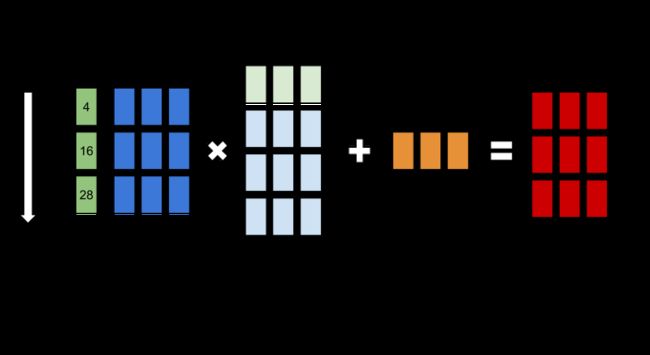这里介绍如何采用TensorFlows(r1.1)构建RNN代码。
什么是RNN网络?
RNN是“Recurrent Neural Network”的简称,用于学习和预测序列数据的一种神经网络。它利用当前时刻的Input和之前的状态State作为输入,计算得到当前的state并预测当前Output。
初始化
这里尝试构建一个用于回音预测的RNN网络,即输出是前几个时刻的输入值。首先采用以下代码进行初始设置。
from __future__ import print_function, division
import numpy as np
import tensorflow as tf
import matplotlib.pyplot as plt
num_epochs = 100
total_series_length = 50000
truncated_backprop_length = 15
state_size = 4
num_classes = 2
echo_step = 3
batch_size = 5
num_batches = total_series_length//batch_size//truncated_backprop_length
生成数据
生成随机序列,并reshape成若干batch。既能加速训练,也能提高鲁棒性。
def generateData():
x = np.array(np.random.choice(2, total_series_length, p=[0.5, 0.5]))
y = np.roll(x, echo_step)
y[0:echo_step] = 0
x = x.reshape((batch_size, -1))
y = y.reshape((batch_size, -1))
return (x, y)
构建模型
占位符和变量
声明用于接收数据的占位符,以及用于训练的变量。
batchX_placeholder = tf.placeholder(tf.float32, [batch_size, truncated_backprop_length])
batchY_placeholder = tf.placeholder(tf.int32, [batch_size, truncated_backprop_length])
init_state = tf.placeholder(tf.float32, [batch_size, state_size])
W = tf.Variable(np.random.rand(state_size+1, state_size), dtype=tf.float32)
b = tf.Variable(np.zeros((1,state_size)), dtype=tf.float32)
W2 = tf.Variable(np.random.rand(state_size, num_classes),dtype=tf.float32)
b2 = tf.Variable(np.zeros((1,num_classes)), dtype=tf.float32)
建模
构建计算图。根据当前输入以及上一时刻的状态生成当前状态
inputs_series = tf.unstack(batchX_placeholder, axis=1)
labels_series = tf.unstack(batchY_placeholder, axis=1)
current_state = init_state
states_series = []
for current_input in inputs_series:
current_input = tf.reshape(current_input, [batch_size, 1])
input_and_state_concatenated = tf.concat(1, [current_input, current_state]) # Increasing number of columns
next_state = tf.tanh(tf.matmul(input_and_state_concatenated, W) + b) # Broadcasted addition
states_series.append(next_state)
current_state = next_state
计算损失函数
采用softmax损失函数。logits_series是对多类概率的预测(这里只有两类),predictions_series是转换成预测label。
logits_series = [tf.matmul(state, W2) + b2 for state in states_series] #Broadcasted addition
predictions_series = [tf.nn.softmax(logits) for logits in logits_series]
losses = []
for logits, labels in zip(logits_series,labels_series):
losses.append(tf.nn.sparse_softmax_cross_entropy_with_logits(logits=logits, labels=labels))
total_loss = tf.reduce_mean(losses)
train_step = tf.train.AdagradOptimizer(0.3).minimize(total_loss)
可视化
可视化训练数据、标签数据和预测数据。当预测数据与标签数据一致则预测正确。
def plot(loss_list, predictions_series, batchX, batchY):
plt.subplot(2, 3, 1)
plt.cla()
plt.plot(loss_list)
for batch_series_idx in range(5):
one_hot_output_series = np.array(predictions_series)[:, batch_series_idx, :]
single_output_series = np.array([(1 if out[0] < 0.5 else 0) for out in one_hot_output_series])
plt.subplot(2, 3, batch_series_idx + 2)
plt.cla()
plt.axis([0, truncated_backprop_length, 0, 2])
left_offset = range(truncated_backprop_length)
plt.bar(left_offset, batchX[batch_series_idx, :], width=1, color="blue")
plt.bar(left_offset, batchY[batch_series_idx, :] * 0.5, width=1, color="red")
plt.bar(left_offset, single_output_series * 0.3, width=1, color="green")
plt.draw()
plt.pause(0.0001)
训练
将所有数据阶段成batch_size×truncated_backprop_length大小的数据,送入模型进行训练。
with tf.Session() as sess:
sess.run(tf.initialize_all_variables())
plt.ion()
plt.figure()
plt.show()
loss_list = []
for epoch_idx in range(num_epochs):
x,y = generateData()
_current_state = np.zeros((batch_size, state_size))
print("New data, epoch", epoch_idx)
for batch_idx in range(num_batches):
start_idx = batch_idx * truncated_backprop_length
end_idx = start_idx + truncated_backprop_length
batchX = x[:,start_idx:end_idx]
batchY = y[:,start_idx:end_idx]
_total_loss, _train_step, _current_state, _predictions_series = sess.run(
[total_loss, train_step, current_state, predictions_series],
feed_dict={
batchX_placeholder:batchX,
batchY_placeholder:batchY,
init_state:_current_state
})
loss_list.append(_total_loss)
if batch_idx%100 == 0:
print("Step",batch_idx, "Loss", _total_loss)
plot(loss_list, _predictions_series, batchX, batchY)
plt.ioff()
plt.show()
全部代码
全部代码如下所示。
from __future__ import print_function, division
import numpy as np
import tensorflow as tf
import matplotlib.pyplot as plt
num_epochs = 100
total_series_length = 50000
truncated_backprop_length = 15
state_size = 4
num_classes = 2
echo_step = 3
batch_size = 5
num_batches = total_series_length//batch_size//truncated_backprop_length
def generateData():
x = np.array(np.random.choice(2, total_series_length, p=[0.5, 0.5]))
y = np.roll(x, echo_step)
y[0:echo_step] = 0
x = x.reshape((batch_size, -1)) # The first index changing slowest, subseries as rows
y = y.reshape((batch_size, -1))
return (x, y)
batchX_placeholder = tf.placeholder(tf.float32, [batch_size, truncated_backprop_length])
batchY_placeholder = tf.placeholder(tf.int32, [batch_size, truncated_backprop_length])
init_state = tf.placeholder(tf.float32, [batch_size, state_size])
W = tf.Variable(np.random.rand(state_size+1, state_size), dtype=tf.float32)
b = tf.Variable(np.zeros((1,state_size)), dtype=tf.float32)
W2 = tf.Variable(np.random.rand(state_size, num_classes),dtype=tf.float32)
b2 = tf.Variable(np.zeros((1,num_classes)), dtype=tf.float32)
# Unpack columns
inputs_series = tf.unstack(batchX_placeholder, axis=1)
labels_series = tf.unstack(batchY_placeholder, axis=1)
# Forward pass
current_state = init_state
states_series = []
for current_input in inputs_series:
current_input = tf.reshape(current_input, [batch_size, 1])
input_and_state_concatenated = tf.concat([current_input, current_state], axis=1) # Increasing number of columns
next_state = tf.tanh(tf.matmul(input_and_state_concatenated, W) + b) # Broadcasted addition
states_series.append(next_state)
current_state = next_state
logits_series = [tf.matmul(state, W2) + b2 for state in states_series] #Broadcasted addition
predictions_series = [tf.nn.softmax(logits) for logits in logits_series]
losses = []
for logits, labels in zip(logits_series,labels_series):
losses.append(tf.nn.sparse_softmax_cross_entropy_with_logits(logits=logits, labels=labels))
total_loss = tf.reduce_mean(losses)
train_step = tf.train.AdagradOptimizer(0.3).minimize(total_loss)
def plot(loss_list, predictions_series, batchX, batchY):
plt.subplot(2, 3, 1)
plt.cla()
plt.plot(loss_list)
for batch_series_idx in range(5):
one_hot_output_series = np.array(predictions_series)[:, batch_series_idx, :]
single_output_series = np.array([(1 if out[0] < 0.5 else 0) for out in one_hot_output_series])
plt.subplot(2, 3, batch_series_idx + 2)
plt.cla()
plt.axis([0, truncated_backprop_length, 0, 2])
left_offset = range(truncated_backprop_length)
plt.bar(left_offset, batchX[batch_series_idx, :], width=1, color="blue")
plt.bar(left_offset, batchY[batch_series_idx, :] * 0.5, width=1, color="red")
plt.bar(left_offset, single_output_series * 0.3, width=1, color="green")
plt.draw()
plt.pause(0.0001)
with tf.Session() as sess:
sess.run(tf.global_variables_initializer())
plt.ion()
plt.figure()
plt.show()
loss_list = []
for epoch_idx in range(num_epochs):
x,y = generateData()
_current_state = np.zeros((batch_size, state_size))
print("New data, epoch", epoch_idx)
for batch_idx in range(num_batches):
start_idx = batch_idx * truncated_backprop_length
end_idx = start_idx + truncated_backprop_length
batchX = x[:,start_idx:end_idx]
batchY = y[:,start_idx:end_idx]
_total_loss, _train_step, _current_state, _predictions_series = sess.run(
[total_loss, train_step, current_state, predictions_series],
feed_dict={
batchX_placeholder:batchX,
batchY_placeholder:batchY,
init_state:_current_state
})
loss_list.append(_total_loss)
if batch_idx%100 == 0:
print("Step",batch_idx, "Loss", _total_loss)
plot(loss_list, _predictions_series, batchX, batchY)
plt.ioff()
plt.show()
参考文献:
- https://medium.com/@erikhallstrm/hello-world-rnn-83cd7105b767
- http://www.jianshu.com/p/1db917db512b
- https://github.com/panyiteng/tensorflow-simple-rnn

